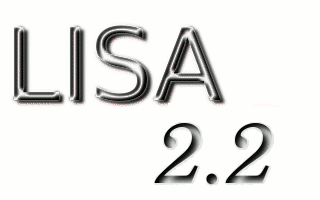Reference manual - LISA specification Languge

uses
special
specification language which consists of regular definitions,
attributes definitions, pointcuts, advice, rules, which are generalized
syntax rules that encapsulate semantic rules and methods in semantic
domains. The LISA specification
language, including apect-oriented features, pointcuts and
advice, has the following parts:
language
L1
[extends L2, ..., LN
] {
lexicon
{
[[Q] overrides | [Q] extends]
R regular expr.
}
attributes
type At1, ..., AtM
pointcut
P <
[S1, ..., Sr] >
L.Y : LhsP ::= RhsP ;
advice
[[B] extends | [B] overrides] A
< [T1, ..., Tr]
> on P [, P1,
..., pn]{
semantic functions
}
rule
[[Y] extends | [Y] overrides] Z
{
X
::= X11 X12 ... X1p
compute {
semantic
functions
|
Xr1
Xr2 ... Xrt compute
{
semantic
functions
};
}
method
[[N] overrides | [N] extends] M
{
operations
on semantic domains
}
}
- L - language name,
- Q and R - regular expression name,
- At - attribute name,
- P - pointcut name,
- S - actual symbol,
- LhsP and RhsP - left and right-hand side of pointcut production,
- A - advice name,
- T - formal symbol,
- X - grammar symbol,
- Y and Z - grammar rules,
- N and M - method name.
As can bee seen from formal specifications above each language in LISA specification starts with reserved word language and has unique name and list of parent language(s) (optional).
language Expression {
// language body
}
language ExpressionOne extends Test {
// language body
}
Lexical analysis
R1 regularexpr1
R2 regularexpr2
Rn regularexprn
The name of regular expression (Ri) is an identifier which is described with following regular expression [a-zA-Z_][a-zA-Z_0-9]*. Regular expression regularexpri is a sequence of characters until the end of current line (spaces are ignored). Regular expressions describe patterns with whom strings of characters in the source program are matched. LISA uses following rules for describing regular expressions:
| expression | matches |
| x | the character "x" |
| \x | "x" even if x is a special character |
| \0xFF | character represented by ASCII code |
| [s] | any character in the string s |
| [x-y] | any character in the range from x to y |
| [^s] | any character not in the string s |
| x* | 0 or more instances of x |
| x+ | 1 or more instances of x |
| x? | 0 or 1 instance of x |
| x|y | an x or y |
| (x) | an x |
| #s | an expression defined by s |
Where special characters (meta-symbols) in LISA's lexical specifications are: | \ ( ) * + ? [ ] - # ^
Each symbol followed meta symbol \ is interpreted as it is (\\ is interpreted by LISA as \).
lexicon {
comment /\*[^\*]+\*/
Some_ink [pr]?ink
Keyword Begin | end
ID [a-zA-Z_][a-zA-Z0-9_]*
NUMBER [0-9]
Integer #NUMBER+
Operator \+ | \- | \* | / | < | > | = | := | \#
Delimiter ; | . | \( | \) | ,
WhiteSpace [\ \0x0A\0x0D\0x09]+
ignore #comment | #WhiteSpace
}
Lexicon part of LISA specifications can be extended using inheritance.
lexicon {
extends Some_ink [lm]?ink // regular expression Some_ink now
// matches also link and mink
}
Syntax analysis
In syntax analysis, tokens of a source program are grouped into grammatical phrases. The task of the syntax analyzer or parser is to determine if a string of tokens can be generated by a grammar phrase. The syntax of the programming language is usually described by the well known BNF notation. In LISA standard BNF conventions are used; context-free productions are specified in the rule part of language definition using following conventions:
| X ::= | X11 X12 ... X1p |
| | | |
| X21 X22 ... X2r | |
| | | |
| | | |
| Xn1 Xn2 ... Xns | |
| ; |
The BNF for arithmetic expressions written in LISA is:
E ::= T EE ;
EE ::= + T EE | epsilon ;
T ::= F1 TT ;
TT ::= * F1 TT | epsilon ;
F1 ::= #Integer ;
F1 ::= ( E ) ;
Semantic analysis
When the syntax of sentences is correct the meaning of sentences or semantics can be computed. The meaning of programs in LISA is described with attribute grammars. An attribute grammar is based on a context-free grammar and associates attributes with the nodes of a parse tree, thus obtaining an attributed or semantic tree. Attribute evaluation rules are associated with the each context-free production. In LISA attribute evaluation rules are written in a block { } which start with keyword compute. This block is inserted between the last symbol of particular production and the character ; or |. Semantic rule in LISA is actually Java assignment statement. To increase modularity of specifications and to enable inheritance of syntax/semantic specifications in LISA these features are part of generalized LISA syntax rules. Each generalized LISA rule has unique name and stars with reserved word rule. For example, to the first two above productions the following semantic rules are associated:
rule Exp {
E.val = EE.val;
EE.inVal = T.val;
};
rule Exp1 {
EE[0].val = EE[1].val;
EE[1].inVal = EE[0].inVal + T.val;
}
| epsilon compute {
EE.val = EE.inVal;
};
Example of inheritance of semantics:
language A {
lexicon {
term a | b
}
attributes int *.a;
rule X {
P ::= a A.P P compute {
P.a = 1 + P[1].a + P[2].a; ; // A.P - early bind
} ;
}
rule Y {
P ::= b compute {
P.a = 1;
} ;
}
}
language B extends A {
rule START {
G ::= P compute {
G.a = P.a;
};
}
rule extends Y {
compute {
P.a = 0;
}
}
}
From specifications above the following monolithic attribute grammar is generated (details can be found here):
B.G = B.P compute { B.G[0].a = B.P[0].a; };
B.P ::= b compute {B.P[a] = 0;}
// B.P ::= a A.P B.P compute { B.P[0].a = 1 + A.P[1].a + B.P[2].a;};
// error indexes must be re-computed
B.P ::= a A.P B.P compute { B.P[0].a = 1 + A.P[0].a + B.P[1].a;}; // O.K.
A.P ::= a A.P A.P compute { A.P[0].a = 1 + A.P[1].a + A.P[2].a;};
A.P ::= b compute {A.P[a] = 1;}
Attributes
Attributes in the node can be of two kinds: the inherited attributes, whose values are obtained from the siblings and the parent of that node in the parse tree, and the synthesized attributes, whose values are obtained from the children of that node in the parse tree. The type of attributes (inherited or synthesized) is derived by LISA an hence is no need to be specified by LISA user. However, the type of attributes and nonterminals to which attributes are attached have to be specified. In LISA the type of attribute can be any valid Java type. In LISA attributes are defined in the block which starts with the keyword attributes. Usually, the same attribute name is attached to many different nonterminals. To avoid unpleasant repeating the wild character * can be used instead. An example of attribute definitions for above example is:
attributes int *.val, EE.inVal, TT.inVal;
Attributes can be inherited from ancestor specifications, but cannot be extended. On the other hand, it is possible that current specifications override ancestor attributes.
Pointcut definitions
Pointcuts are defined using reserved word pointcut. Each pointcut has a unique name and a list of parameters (terminals and non-terminals used in semantic functions of advice). In the pointcut definition one can use two wildcards. The wildcard '..' matches zero or more terminal or non terminal symbols and can be used only to specify right-hand side matching rules. The wildcard '*' is used to match parts or whole literal representing a symbol.
pointcut First<T, EE> Expression.* : * ::= * EE ;
pointcut Second<T, EE> *.* : EE ::= .. EE ;
Inheritance of pointcuts is defined in similar manner as for attributes. Pointcuts as well as attributes cannot be extended, but can be inherited from ancestor attribute grammars. It is possible that some pointcut is redefined in current specifications which override pointcut specified in ancestor specifications.
Advice
advice Beg<a, b> on First {
a.val = b.val + 1;
}
Advice can be applied on several pointcuts in same language or in parent language(s). Error appears if same advice should to be applied to several pointcuts.
Advice inheritance is defined in a similar manner as for semantic rules (both defines semantics).
advice extends Beg // semantics of that advice will be applied on same
// pointcut as ancestor advice
advice Begin extends Beg // same as previous example; advice has different name
advice overrides Beg // only semantics of this advice will be applied on
// specific pointcut; overriden advice cannot be
// applied to any pointcut after has been overriden
// once
advice extends Lx.Beg // this advice extend advice Beg of language Lx
Operations On Semantic Domains
Additional semantic calculations can be implemented in method part of LISA specifications. Method part starts with reserved word method followed by an unique name. All operations must be defined beetwen { }. Method part consists of native Java code (legal Java code == legal LISA method code). Java methods defined in method part of specifications can be used in semantic equations (LISA generalized rules).
rule someRule {
A ::= a A compute {
A.attr = calculate(A[1].attr);
}
}
method SomeMethod {
import java.util.Hashtable;
public Hashtable calculate(Hashtable aAttr) {
return someHashtable;
}
}
Operations on semantic domains are also subjet of inheritance. You can extends or defeat (change) methods inside method part in extended Languages. In the example below, method calculate will be replaced with new version.
method overrides SomeMethod {
public Hashtable calculate(Hashtable aAttr) {
return someNewHashtable;
}
}


